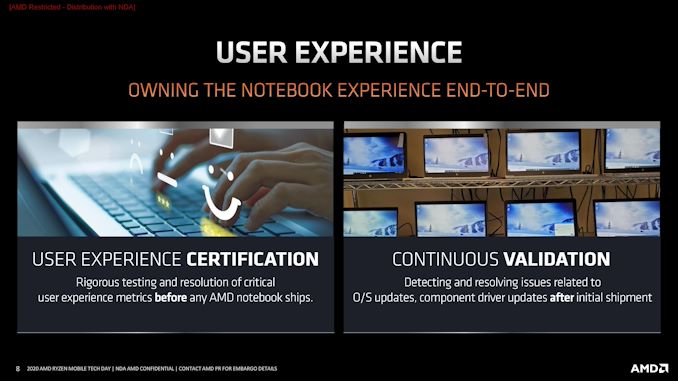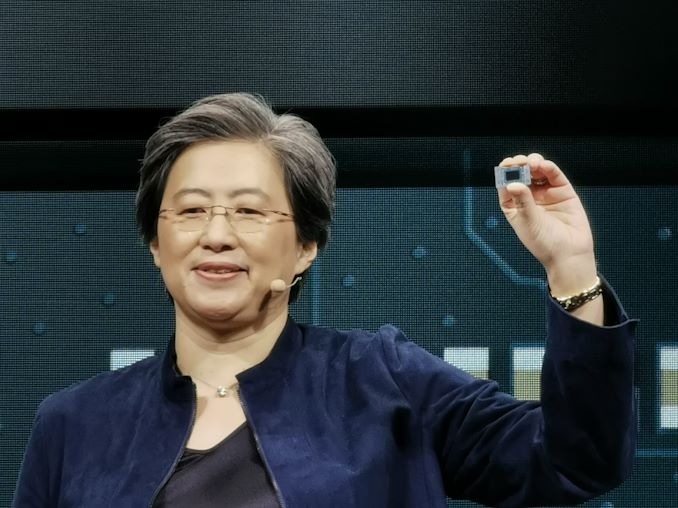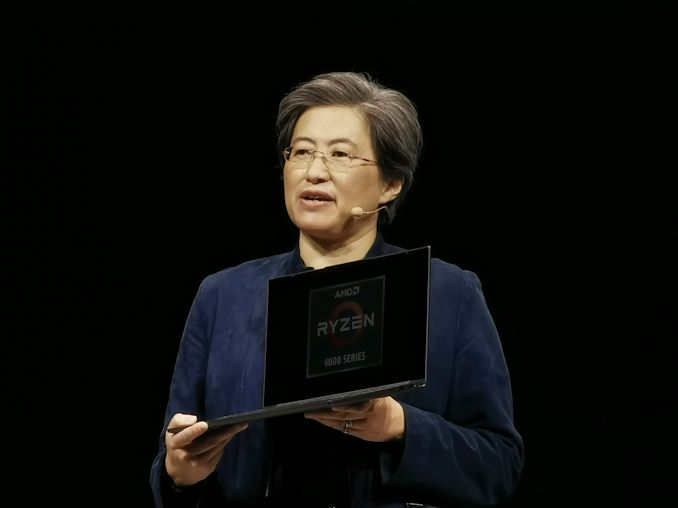AMD Details Renoir: The Ryzen Mobile 4000 Series 7nm APU Uncovered
by Dr. Ian Cutress on March 16, 2020 11:00 AM ESTThe Special HS Processors
As mentioned, at the top end of the new Ryzen Mobile 4000 list are the HS processors, offering almost exactly the same specification as the 45 W H-series processors, but at 35 W. AMD has marked these as special processors, not available to every OEM, because they fall under AMD’s new cooperative design and continuous validation programs.
In order to be able to use a HS processor, an OEM must work with AMD on the design. This is similar to what Intel does – ensure that the OEM partner gets the best from the hardware, and try and assist as to what design decisions the hardware was built for. Ultimately the product that comes out should be one that shows off the best of the hardware and gives the best user experience. On top of this, AMD has a list of ‘assured components’, validated to work against the new processors, and has created two continuous validation labs.
These labs, one in Austin and one in Shanghai, take the systems and pre-test all the new drivers and vendor software on them before they are released to the public. This is to ensure that the system is in no way compromised in performance, power, or thermals as a result of the update (to ensure that a company doesn’t completely mess with the power profile after it launches through a BIOS update or similar). AMD didn’t state how long its continuous validation program will run after the product is shipped, though I should think that at least 12-18 months should be plausible.
If the OEM does all this, and AMD agrees, then the product can use one of the HS processors.
(Note, the normal 45 W processors can be run in a 35 W mode, but just doing that doesn’t mean you can call it a HS. No doubt some third-tier OEM might try…)
The first HS-class system on the market will be the ASUS Zephyrus G14, and we learned in January that ASUS’s design has an exclusive for six months from launch. We’re expecting the G14 to hit the market in Q2, even with the current state of production, so we’ll see more HS models later in the year.
Conclusions
Ultimately today was the day that AMD was going to lift the embargo on Ryzen Mobile 4000 reviews, with the systems that AMD and its partners have provided. Due to the current ongoing issues around the world, those technical reviews of the systems will have to wait a few weeks while production is being ironed out. But for now we have a good grasp as to what AMD has pushing into the new processors coming out later this year.
Regular readers of AnandTech may remember back in 2016 I wrote a very long piece about AMD’s laptop strategy, where I tested five laptops from OEMs that were using AMD’s latest Carrizo APU at the time. The conclusions to that review were three fold: AMD was shooting itself in the foot by providing a platform that allowed its partners to be cheap; the OEM partners were being cheap by giving the hardware 13x7 screens, poor storage, poor trackpads and such because that’s all the customers seemed to want; and the customers were continually asking for cheaper systems, then getting frustrated with the poor user experience, ultimately blaming AMD rather than the OEM. It was a vicious cycle that required someone to break it.
Normally for these launches, a company will create a reference design for its partners to work with. AMD for years was creating these dull $500-$700 reference designs, which ultimately led to the paragraph above. We pled for generations for AMD to make a halo reference design, something ultraportable for $1500. For Renoir, given the reasonable performance uplift from the previous generation, the company worked with partners to create a range of high profile devices. I’ve covered a few of them in this article – the Lenovo Yoga Slim 7, the Dell G15 SE, and the ASUS Zephyrus G14 all attack different markets in very different ways, but all are examples of high-end products and design wins that AMD has needed in this market.
One of AMD’s big targets here is commercial. Despite the poor consumer performance of its older generations of laptops, the commercial laptop arm of AMD did reasonably well by comparison. AMD has announced its Ryzen Mobile 4000 Pro designs that afford admin control and sustainability over the lifetime of the product, and the key win here is that we’re seeing the processors in Lenovo’s Thinkpads, a key market.
The other big market is gaming. AMD can attack this on two fronts - the ultraportable market with the improved integrated graphics should get some good perfomrance, but also the more power hungry gaming market will get access to features like SmartShift to help balance the power between the APU and discrete GPU. AMD is also playing in the middle market here, with devices like the ASUS Zephyrus G14 with a HS processor and a Radeon RX5600M inside a 14-inch chassis, which AMD claims is the first 14-inch device with a H-class CPU and a discrete GPU inside. AMD's gaming team seem to be very happy with this design.
However, announcing systems is one thing. Deploying them is another. AMD has made a lot of claims about its Ryzen Mobile 4000 platform – performance, power consumption, and battery life. We’ve gone into detail into a lot of these, but we’re still missing one piece of the puzzle – the on-hand data. We’re hoping to get a system or two here in due course, and compare it against the competition.














95 Comments
View All Comments
Spunjji - Tuesday, March 17, 2020 - link
Oof. Thanks for sharing that, but I feel like I know more than I ever wanted to about CODECs... and still not enough :'Dikjadoon - Tuesday, March 17, 2020 - link
Codecs live or die by industry & content support. I don't see *anyone* major taking up H.266, much less EVC or LCEVC.The transition to AV1 is not merely technical, but also political. MPEG Group has sowed their own demise.
Two of H.265's patent pools backed away away, scared of AV1's enthusiasm. I don't see Sisvel's snivelling going far, even with the latest batch of patent "disputes". How is their VP9 patent pool going?...
VVC's bit-freeze is when...2021? It'll take years for decoding hardware and *nobody* is eager to run back to MPEG.
A good read: https://www.streamingmedia.com/Articles/ReadArticl...
March 2020 update: https://www.streamingmedia.com/Articles/News/Onlin...
MPEG, Sisvel, etc. missed the boat about a half decade ago.
name99 - Thursday, March 19, 2020 - link
Firstly, don't confuse the world as you wish it to be from the world as it is.Apple is all on on h.265, and ATSC3, the next US digital TV spec, already in preliminary usage in some markets, is based on h.265. When you stream netflix at 4K UHD, you're probably using h.265.
Secondly, be aware of the schedules.
For h.265, the first version of the spec was 2013. By Sept 2015 Apple released the A9 with 265 decode, and a year later the A10 with 265 encode.
BUT these were only exposed to the public in 2017 with iOS11. The point of the delay,
presumably, was to ensure a large enough critical mass of users already at the point of announcement.
This suggests that Apple will be planning a similar transition of their entire line to VVC, but it will take time -- maybe a decoder chip in 2023, an encoder in 2024, a public commitment to "the new Apple codec is VVC across all devices" in 2025.
The relevance of Apple is that Apple is something of the leader in this space. Sure, sure, there's a tiny world of open source renegades talking about Dirac and Opus and Matroska and suchlike. But in the real world of serious money, Apple generally represents the vanguard.
So these future codecs are interesting, yes. But they're also only going to be mainstream relevant (if you're with Apple) maybe late 2025, for everyone else maybe a year or so later?
name99 - Thursday, March 19, 2020 - link
Oh I realize I left out one point.We saw exactly the same stories back when h.265 became relevant. Here's a sample thread:
https://forums.anandtech.com/threads/h-264-vs-h-26...
Complain all you like about the existence of patent pools, but they are just not that big a deal to the big boys, especially hardware. So Apple, or your Samsung/LG/Sony TV has to pay 1, or 5 dollars per device. That's perfectly feasible in return for a spec that is both very good, and more or less legal certainty.
There's just no reason to believe the driving forces in 2025 are any different from those in 2015.
grant3 - Tuesday, April 14, 2020 - link
"they are just not that big a deal to the big boys, especially hardware"And yet it's "big boys" like intel, cisco, google, samsung, nvidia etc. and oh ya, APPLE, who are the founding members of the royalty-free Open Media alliance i.e. the developers of AV1.
Hifihedgehog - Monday, March 16, 2020 - link
How much later is later, guesstimate-wise? :)Kevin G - Monday, March 16, 2020 - link
I was expecting B550 around Computex (which is still a go last I checked). However with the recent outbreaks, I wonder how much has been pushed back or will simply be a preview then. Supply chains are disrupted at various points. I'm just curious what we know has been pushed back, what is still on schedule and what is likely to be affected that hasn't yet. I'd make for an interesting piece. :)AshlayW - Monday, March 16, 2020 - link
Asbolutely hyped to pick up a 4400G(?) for my Slim system. Currently has a 3400G but we are edging closer to me being able to play all the games I like at 1080p, on a single chip system.dianajmclean6 - Monday, March 23, 2020 - link
Six months ago I lost my job and after that I was fortunate enough to stumble upon a great website which literally saved me• I started working for them online and in a short time after I've started averaging 15k a month••• icash68.coMpeevee - Monday, March 23, 2020 - link
On a desktop APU it would make sense to separate CPU and GPU dies, there is plenty of space and yields would be higher. Of course the GPU side should be Navi and socket should be upgraded to 4 memory channels to allow a truly decent integrated GPU similar to 5500.